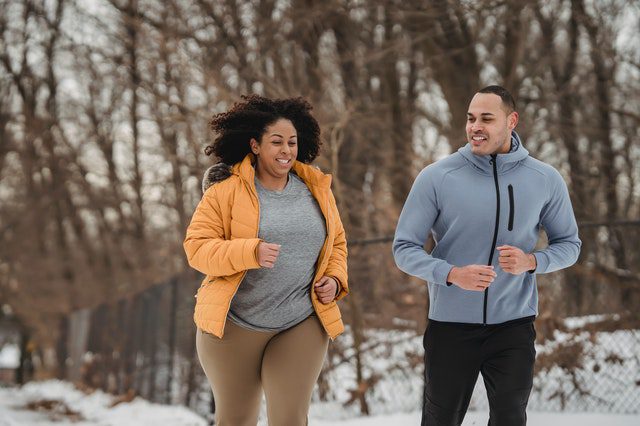As the summer turns to winter, most joggers think about whether they should tough out the cold or buy a treadmill. They may be thinking of retiring their running shoes altogether. If you started working towards your fitness goals this year, you don’t have to stop now!
In fact, there are several ways you can make cold weather running less of a slog. Use these ten tips from cold weather pros to make the best out of your workout routine once the chilly weather hits.
Table of Contents
1. Lure Yourself Out the Door
One of the hardest things about jogging in the winter is willing yourself to do it. In places like Canada or the Northern United States, temperatures can get as low as -22°F (-30°C), which unsurprisingly deters a lot of runners. Try to run with a friend or reward yourself after a run.
2. Do a Pre-Run Warm Up
Instead of immediately running for the door, do a few jumping jacks, high knees, and burpees before leaving the house. The cold won’t feel so cold when you’re already warm. Several runners even take this time to quickly clean their house or do a short yoga session.
3. Stretch Before Your Workout

Speaking of a short yoga session, you should always stretch before running, especially if you just woke up. A 5-minute stretch routine can reduce your risk of injury, increase your range of motion, improve your posture (important in running!), and promote healthy circulation.
4. Dress for Success
You’ll want to be warm without sweating too much, or you’ll catch a chill. Wear layered shorts over tights or leggings for added protection. The best running shorts will vent air as you heat up. Don’t forget to wear a light jacket, proper running shoes, gloves, and a hat when going out in the cold weather. Wear a knee sleeve to protect your knees.
5. Run Against the Wind
Many joggers will run against the wind to prevent the cold breeze from blasting them in the face. To avoid a long, biting jog, run into the wind for about 10 minutes, then turn around with the wind on your back for 5. Repeat. Make sure none of your skin is exposed.
6. Wear Reflective Gear
You’ll likely be running at night if you have a regular 9-5, but you could endanger yourself if you don’t put on some reflective or fluorescent gear. It’s in your best interest to light yourself up like a Christmas tree, seriously! Otherwise, you may get hit by passing cars or bicycles.
7. Don’t Skimp on Your Running Shoes
Without proper running shoes, you may start slipping around all over the place. Purchase shoes with a Tarantula anti-slip seal of approval to ensure that your feet grip the ice. To keep yourself warm, wear socks that wick away the wetness of your feet. Avoid wool socks!
8. Be Flexible with Mileage and Pace
Joggers have said their eyelashes would freeze together, or their breath would be so cold that it hurt their throat. If the cold is that extreme, you can call it a rest day, work out on a treadmill, or separate your runs in half. Run once in the morning and once at night if necessary.
9. Find Higher Ground
At 300 feet up, it can be 15-20 degrees warmer, so if you live in a hilly part of the country, try to find higher ground. Plus, running up a hill burns more calories and trains your endurance faster than jogging on flat pavement. It’s a win-win for your fitness and warmness!
10. Change Post-Run
As soon as you get home, change out of your running clothes. Either get into the shower immediately or put on a sweater, beanie, and sweatpants. Drink some coffee or put on a pot of some hearty soup. If you’re going to a coffee shop after your run, change in the bathroom.
Featured Photo by Julia Larson from Pexels




